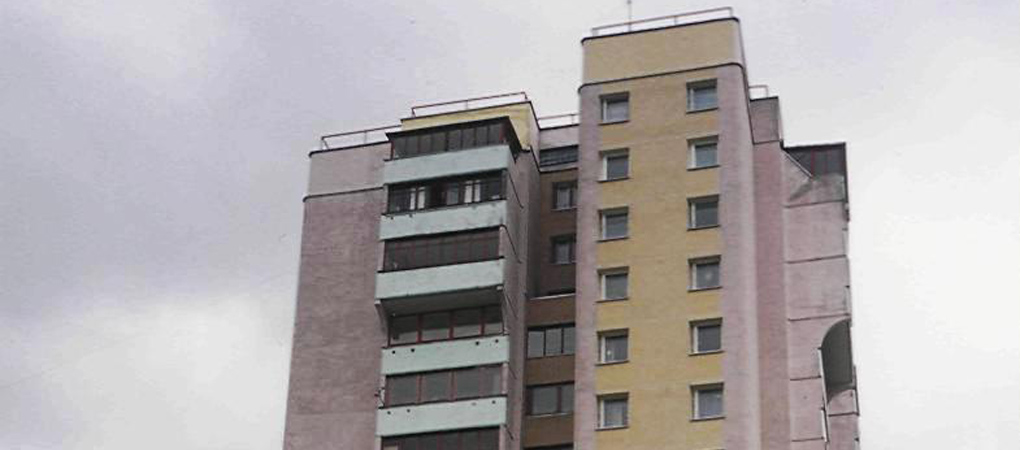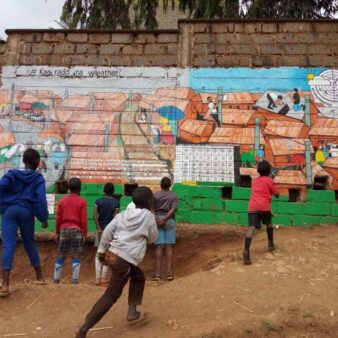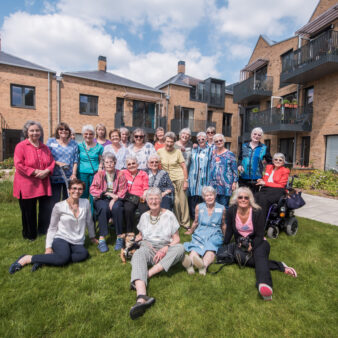An innovative and affordable financing system has enabled homeowners in large crumbling apartment blocks to upgrade, maintain, and improve the energy efficiency of their accommodation. The programme to improve this former state-provided housing operates through 1,100 individual homeowners’ associations. An average energy saving of 25 per cent has been achieved per apartment and residents find that working together has promoted greater social cooperation and inclusion.
Project Description
Aims and Objectives
- To develop maintenance of housing infrastructure by stimulating private initiative and investment.
- To achieve greater energy efficiency.
- To introduce long-term affordable financing schemes.
- To develop the private sector.
After the break-up of the Soviet Union Lithuania inherited housing with very low energy efficiency compared to the rest of Western Europe. It is largely dependent on imported fuel and with the high and rising prices of energy; one of the main objectives of the Lithuanian government was to facilitate cost-effective implementation of energy efficiency measures in residential and public buildings. Around 800,000 of the 1,300,000 of Lithuania’s households live in one of the 30,000 apartment blocks. Significant share of households are reported to have difficulty in paying their energy bills.
In the early 1990s a comprehensive privatisation programme meant that 90 per cent of former tenants acquired titles for their apartments practically at no cost. The building infrastructure and common areas were retained in communal ownership and consequently housing maintenance and modernisation issues were largely ignored. Owners had not formed homeowners associations and took no responsibility for their apartments or the communal space in and around them. As a result the condition of apartment blocks deteriorated rapidly. It was recognised that if the situation continued the wealthier residents would move out of these blocks, leaving them as ‘ghettos’ for those living on the lowest incomes.
A multi-sourced funding and technical support package has been used to establish the Energy Efficiency Housing Pilot Project and enable households to improve the energy efficiency and renovate their crumbling apartment blocks. A $10 million loan agreement was signed between the World Bank and the Lithuanian government in August 1996 for a five year pilot project, 53 per cent of which was for housing and 47 per cent for schools.
Homeowners and municipalities were able to obtain soft loans to finance investments in technically and economically attractive packages of energy efficiency measures. Support was only available to groups of homeowners who had formed a homeowners association. Following the successful pilot project the repaid loans were granted to the Lithuanian government to establish a revolving fund to continue the programme. To date 20 per cent of all apartment blocks are managed by Homeowners Associations. In some cities this exceeds 70 per cent.
Prior to the project commencement the legal and financial systems had to be amended to support the operation of the loan programme by allowing homeowners associations to obtain bank loans without mortgaging individual apartments. Loans were extended to homeowners via selected commercial banks in order to accustom the Lithuanian banking sector to this type of lending. Typical work carried out as part of the project included replacement of heating systems, wall and roof insulation and replacement of doors and windows.
The Housing Advisory Agency via its regional centres provided comprehensive support to participating homeowners and conducted numerous public awareness campaigns. A training programme for local energy consultants was expanded to help improve their services. Consultants from Danish and Dutch governments helped to train 193 local energy consultants, develop project documents, and carry out technical and social monitoring of implemented projects. All participants have much greater awareness of issues regarding energy saving, building modernisation and project financing.
Resident involvement and cooperation was essential for the success of the project, as the forming of a homeowners association was necessary in order for residents to take out a communal loan. Membership of an association is not compulsory for residents but there has to be more than 50 per cent agreement from all residents before renovation of the property is undertaken however once the decision is taken all residents are bound by it. Significant public outreach was necessary to ensure that homeowners wanted to become involved.
It is the homeowners’ responsibility to organise the management and maintenance of their blocks. The associations usually hire maintenance companies to carry out the work for them. Where there is no homeowners association in an apartment block the city council assigns a municipal or private administration company and the residents have only a marginal role.
The World Bank provided a $10 million loan; the Lithuanian government contributed 30 per cent matching funds and the homeowners associations had to contribute 10 per cent of the cost in order to be eligible for a loan. After completion of the pilot phase of the project the investments were financed from the repaid from the revolving funds fund. To date, homeowners have repaid $12 million of the borrowed funds including interest.
The main beneficiaries of the project are the 60 per cent of the population of Lithuania who became homeowners of apartments as a result of the government’s privatisation policy. To date over 1,100 homeowners associations are involved with the scheme and 558 of them have signed loan agreements for more than $26 million bringing improved living conditions to 25,000 households. Energy efficiency measures have also been implemented in 53 schools and kindergartens, benefiting 27,000 pupils. Local municipalities have also benefited through reduced costs for subsiding energy payments for low-income households.
Why is it innovative?
- It is a genuinely demand driven undertaking which started a societal shift in Lithuania from the ‘soviet’ style centralised housing maintenance and renovation system towards a market-based sustainable system that involves residents in all decision making, whilst providing support for low-income families and fostering social cohesion.
- Legal and institutional innovation to allow commercial banks to be involved in the financing of the renovation of apartment blocks.
- Synergy of all stakeholders removed all bottlenecks and ensured the overall success of the project.
What is the environmental impact?
Improvement of the energy efficiency of the buildings has led to a reduction of greenhouse gas emission, with a calculated annual CO2 saving of 12,000 – 22,000 tons per annum. Technical monitoring has shown that there are 20 – 30 per cent heat savings on average.
The introduction of energy management systems have been successful and have great potential to be scaled up since they do not require large amounts of investment but simply a greater awareness of what can be achieved through simple energy saving measures.
Enhanced awareness of energy saving issues is carried out through radio and TV programmes and a regular newsletter is distributed to all homeowner associations. The city of Panevezys has used the project to upgrade its district heating networks by installing a modern heat substation in each apartment block as part of the upgrading programme. Since there is less consumption of fuel oil there is less air pollution, especially in heavily built up areas. Asbestos was removed from the apartment blocks as part of the renovation works.
Is it financially sustainable?
The World Bank has permitted the Lithuanian government to use the repaid loan funds to establish a revolving fund and this began operation in 2001 and a good repayment rate will ensure its continuity. A few associations have minor arrears but there are no defaulters. The commercial banking sector is now capable of lending funds for such programmes and grant support is being gradually reduced, although there is increased targeting of available grant resources on the lowest income households and this will continue in the future.
Sixty per cent of the households surveyed found that the loan burden was insignificant or negligible and 35 per cent found that it was a significant burden. A survey of those participating in the programme has shown that 56 per cent of all households now have reduced heating bills and the average reduction is 25 per cent, after adjusting for an increased comfort factor. Carrying out the energy improvements usually increases the market price of an apartment, thereby increasing the value of the owner’s assets.
What is the social impact?
The need for homeowners to work together has helped improve social integration and the improvement in quality of the blocks means that different income groups have continued to live together. The creation of ghetto or sink blocks has been avoided by encouraging the wealthier families to stay in the blocks, thus ensuring a broader range of income and social groups.
Training and seminars have been provided for all members of homeowners associations and they are encouraged to take a greater part in decision-making regarding communal parts of their apartment blocks. This is carried out by voting in community meetings. Clear guidance is provided on voting procedures and rules so that there is a transparent process with no misunderstandings.
Barriers
- The lack of a proper legal and regulatory framework to facilitate the formation of homeowners associations and energy efficiency investments was addressed with public information campaigns and by increasing the financial accountability of borrowers.
- Lack of collateral is an obstacle to private sector lending and is addressed by the government acting as guarantor of last resort.
- Public awareness campaigns were not enough to convince homeowners and it was necessary to give financial incentives in the form of tax benefits and grants.
- Privatisation of municipal maintenance companies would encourage the formation of homeowners associations by giving choices and lower costs for maintenance services.
Lessons Learned
- Homeowners are able and willing to renovate common property if provided with institutional and technical support and financial incentives.
- Homeowners associations take debt seriously and are repaying loans, often faster than needed.
- Case studies and examples have an important demonstration effect when communicating to homeowners.
- The main motivations for homeowners when they decide to take a loan are to improve their own apartment, to carry out urgent repairs on the building and to obtain energy savings.
- After project implementation homeowners become more interested in energy savings and some start planning new projects.
- Metering in individual apartments and thermostatic valves and heat cost allocators on the radiators have demonstrated high levels of energy saving and resident satisfaction. On average, having adjusted for increased comfort levels, 25 per cent energy costs savings are achieved per household.
Evaluation
The World Bank and the Lithuanian government have carried out monitoring of key performance indicators.
Transfer
- The project has received considerable attention from Lithuanian and foreign housing and energy policy makers, researchers and mass media. Numerous articles have been published and TV and radio programmes have been broadcast.
- A series of academic articles, conference papers and scientific studies have also been published by a range of authors.
- The project started from the largest cities of Lithuania but it is now being extended to more than 20 cities and towns all across the country.
- 558 homeowners associations have entered into the project to date, with a further 160 new projects taking place in 2005.
- Visitors from overseas have visited the project.
Partnership
National Government, Donor Agency, International Agency



